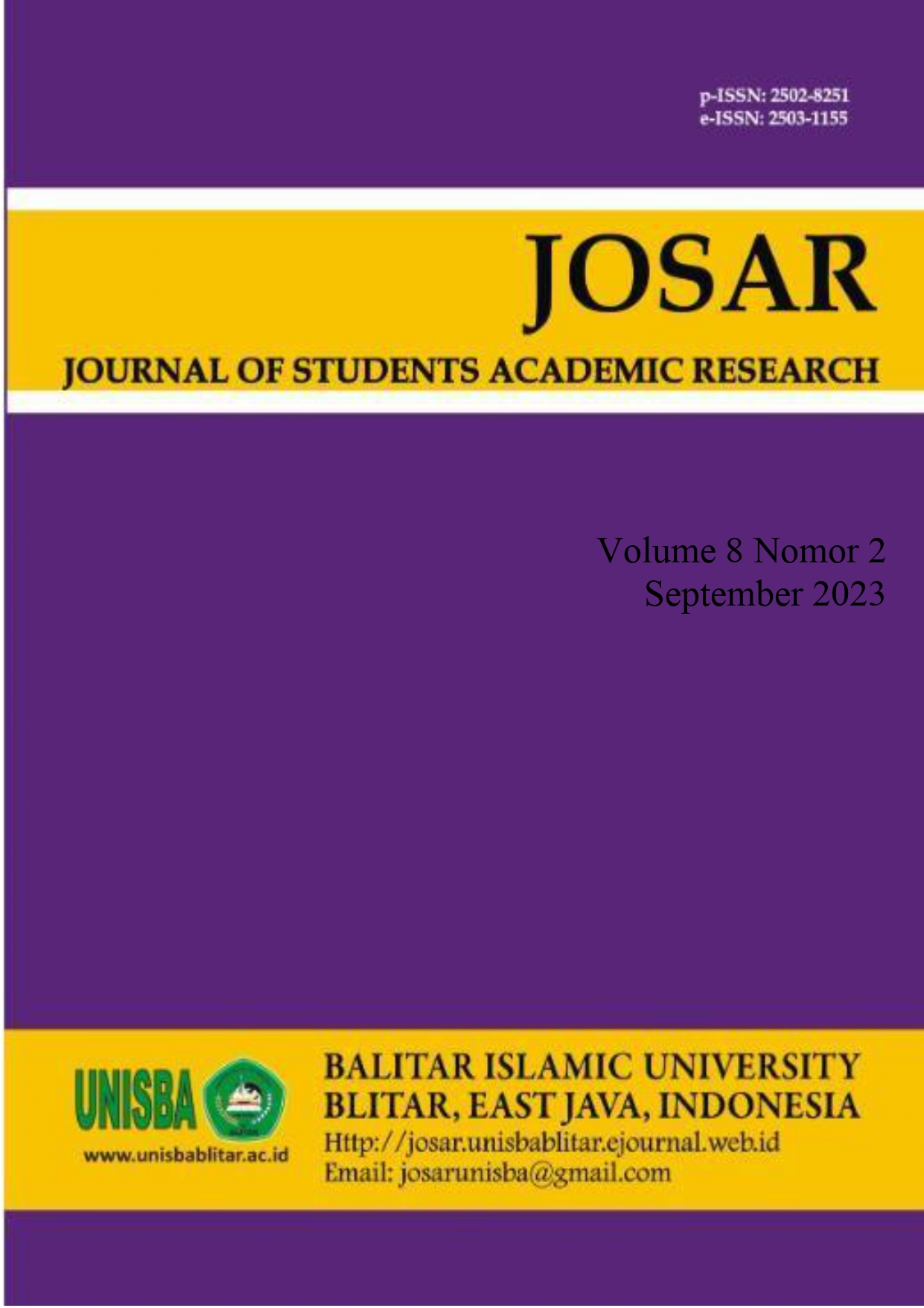DEVELOPMENT OF A SURROUNDING ENVIRONMENT BASED LEARNING BOOK FOR STUDENTS AT SDN PURWOREJO 03 SANANKULON
DOI:
https://doi.org/10.35457/josar.v8i2.3157Keywords:
Javanese; Kewan; Wit-Witan; Supporting Books, EnvironmentAbstract
The objectives to be achieved in this research are to analyze the Feasibility of the Environment-Based Kewan Lan Wit-Witan Javanese Language Support Book at SDN Purworejo 03 Sanankulon Blitar and to analyze the Effectiveness of the Environment-Based Kewan Lan Wit-Witan Javanese Language Support Book at SDN Purworejo 03 Sanankulon Blitar. This research is included in development research which uses a Research and Development (R&D) approach. This development research is longitudinal (gradually) to develop a new product or improve an existing product and test its effectiveness so that it can function in the wider community. The results of the research are environment-based interactive learning media about animals and plants (Kelantan) by material experts considered appropriate with a percentage of 86.25% media experts rated "appropriate" with a percentage of 85%, and linguists rated "appropriate" with a percentage of 88.60%. Then The level of readability of interactive learning media based on the surrounding environment about animals and plants (Kelantan) by material students is considered very feasible with a percentage of 90%.
Keywords: Javanese; Kewan; Wit-Witan; Supporting Books, Environment
References
Azwar, S. (2007). Sikap manusia: Teori dan pengukurannya.
Emzir, A. D. (2011). Metodologi Penelitian Kualitatif. Jakarta: Rajawali Pers.
Fatimah, A. W. N. (2015). Pengaruh Penggunaan Media Pembelajaran dan Minat Belajar Terhadap Prestasi Belajar Sejarah Siswa Kelas XI MIA SMA Negeri Kebakkramat Tahun Pelajaran 2014/2015.
Hamalik, O. (2003). Prosedur belajar mengajar. Jakarta: Bumi Aksara. Hasanah, R. S., & Sumiharsono, R. (2017). Media Pembelajaran.
KARIYADI, E. F. E. (2013). Upaya Guru Dalam Mengatasi Kesulitan Membaca Permulaan Siswa Kelas 1 SDN 2 Suwawa Kabupaten Bone Bolango. Skripsi, 1(151409148).
Nurfadillah, A. (2018). Penggunaan Media Komik Untuk Meningkatkan Keterampilan Berkomunikasi Dan Hasil Belajar Siswa Kelas Iv Tema Indahnya Kebersamaan Subtema Keberagaman Budaya Bangsaku (Studi Penelitian Tindakan Kelas di Kelas IV SD Negeri 1 Malangbong Kabupaten Garut Tahun Ajaran 2018/2019) (Doctoral dissertation, FKIP UNPAS).
Ramadhan, M. A., & Sugiyono, S. (2015). Pengembangan sumber dana sekolah pada sekolah menengah kejuruan. Jurnal Pendidikan Vokasi, 5(3), 340-351.
Romadhoni, A. (2018). Kompetensi Pedagogik Guru dalam Penggunaan Media Pembelajaran di Kelas VB SDN No. 55/1 Sridadi. Kompetensi Pedagogik Guru dalam Penggunaan Media Pembelajaran di Kelas VB SDN No. 55/1 Sridadi.
Sabar, M. F. F. A., Akhter, M., Faiz, F. A., Ali, S. S., & Ahmad, M. (2007). Identification of restorers and maintainers for developing hybrid rice. J. Agric. Res, 45(1), 440-447.
Sanjaya, H. W. (2016). Media komunikasi pembelajaran. Prenada Media.
Sitepu, B. P. (2012). Pengembangan Taman Bacaan Masyarakat Sebagai Sumber Belajar. Jurnal Ilmiah Visi, 7(1), 42-56.
Sudjana, N., & Rivai, A. (2010). Media pembelajaran. Bandung: Sinar Baru Algensindo.
Sukmadinata, N. S. (2009). Metode Penelitian Pendidikan Cetakan Kelima. Bandung: PT. Remaja Rosdakarya.
Sukmadinata, N. S. (2013). Metode penelitian pengembangan. Bandung: Remaja Rosakarya.
Syamsuddin, S., & Syamsuddin, S. (2003). Hermeneutika Alqur'an mazhab Yogya.Islamika.
Tarigan, J. (2008). User satisfaction using Webqual instrument: A research on stock exchange of Thailand (SET). Jurnal Akuntansi dan Keuangan, 10(1), 24-47.
Downloads
Published
Issue
Section
License
Authors who publish in this journal agree to the following terms:
- Authors retain copyright and grant the journal right of first publication with the work simultaneously licensed under a Creative Commons Attribution License that allows others to share the work with an acknowledgment of the work's authorship and initial publication in this journal.
- Authors are able to enter into separate, additional contractual arrangements for the non-exclusive distribution of the journal's published version of the work (e.g., post it to an institutional repository or publish it in a book), with an acknowledgment of its initial publication in this journal.
- Authors are permitted and encouraged to post their work online (e.g., in institutional repositories or on their website) prior to and during the submission process, as it can lead to productive exchanges, as well as earlier and greater citation of published work (See The Effect of Open Access).
Deprecated: json_decode(): Passing null to parameter #1 ($json) of type string is deprecated in /home/ejournal.unisbablitar.ac.id/public_html/plugins/generic/citations/CitationsPlugin.php on line 68










